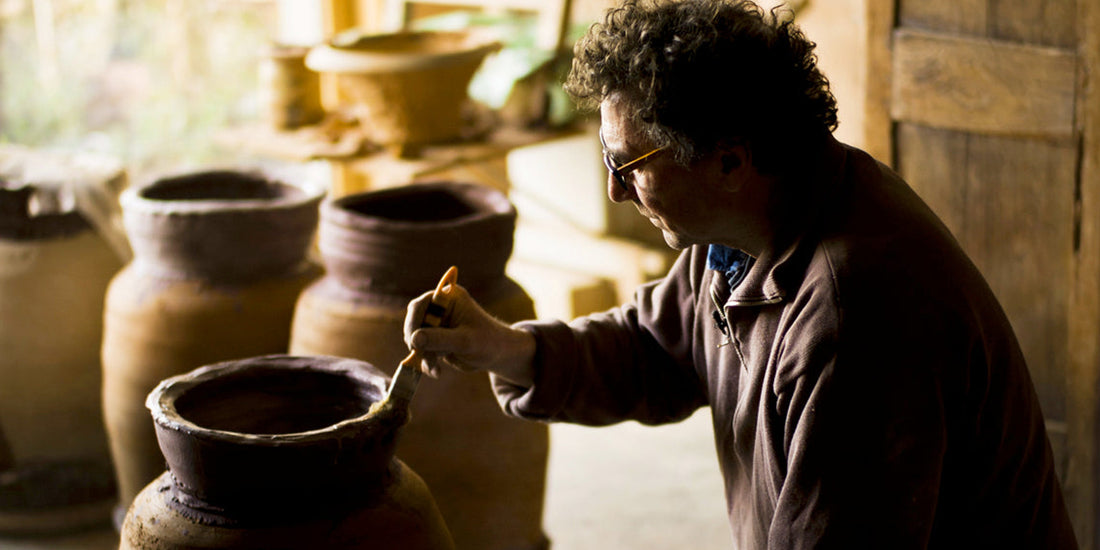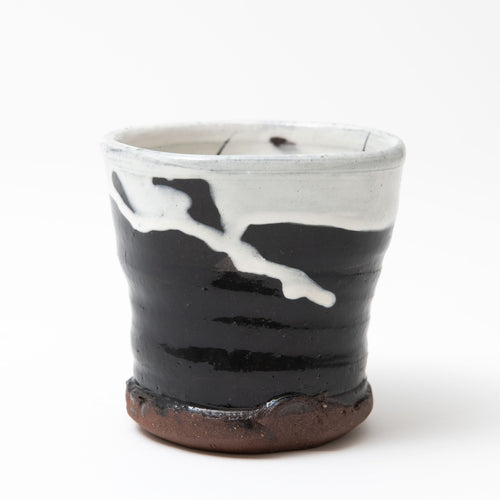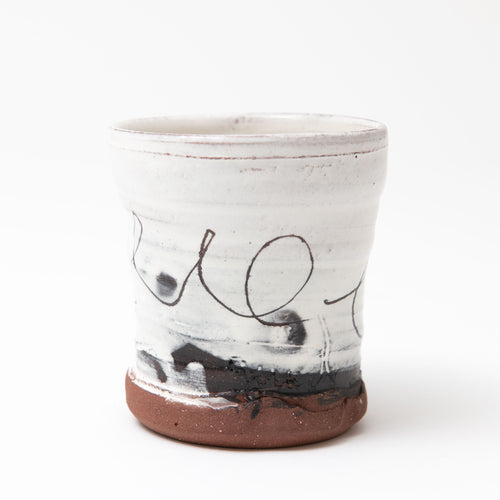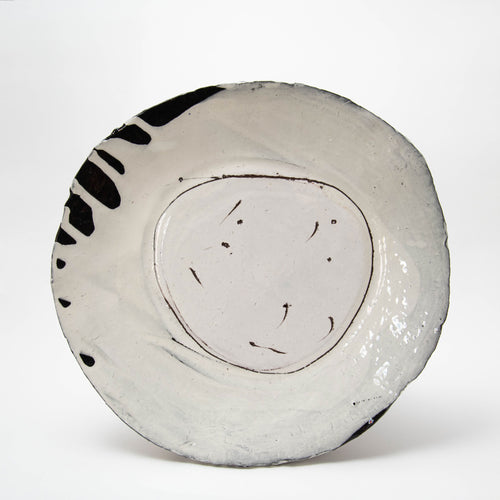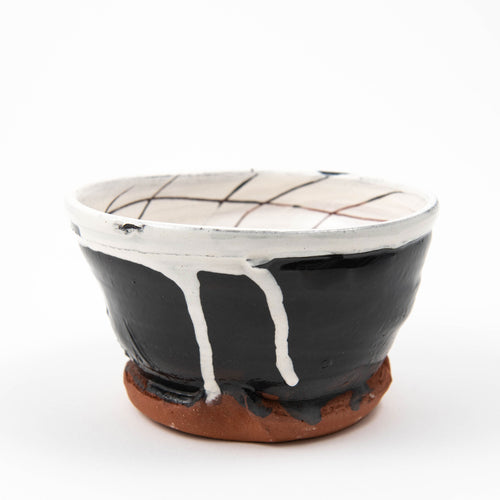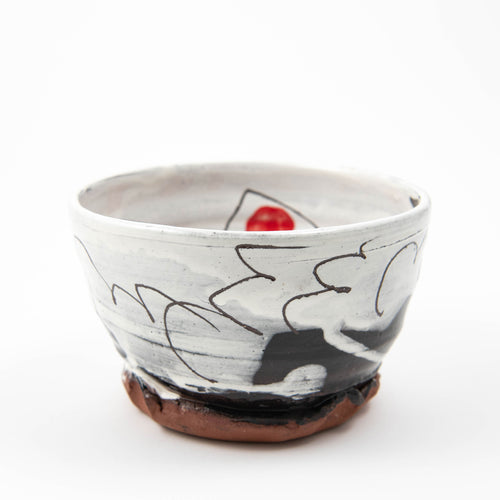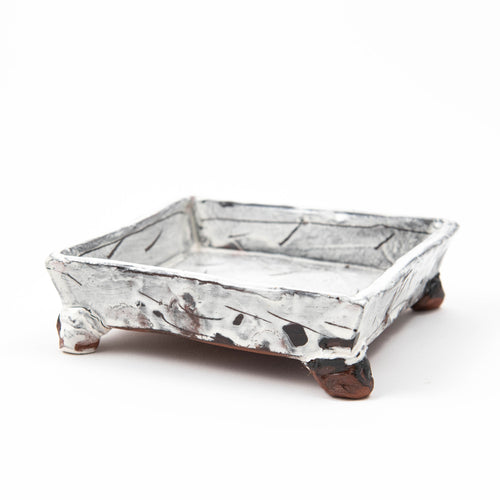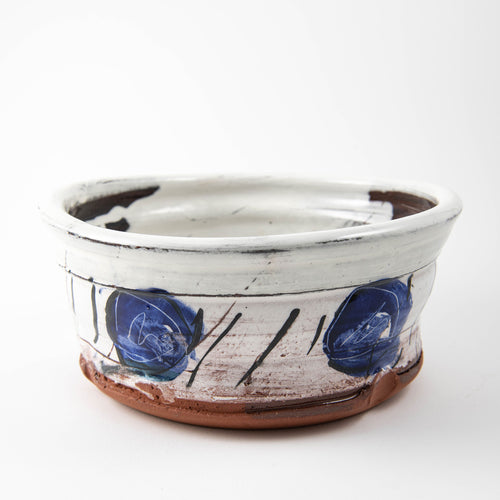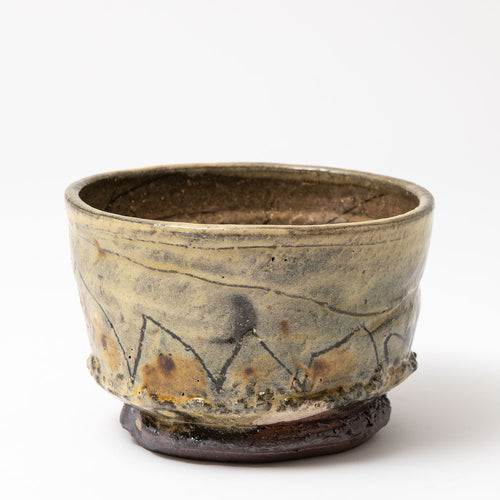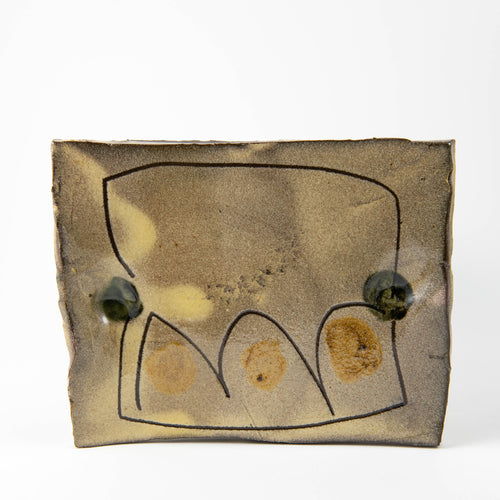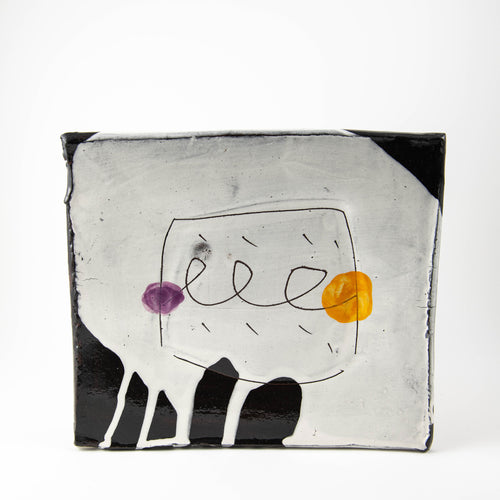Back in 2014, Ceramic Review published an article of ours celebrating the joyful work of gallery potter Jean-Nicolas Gérard.
To coincide with a magnificent recent restock of Jean-Nicolas' work, totalling a whopping 296 pots, we thought we'd republish our article here for you all to enjoy. Read on below.

In my step-father’s kitchen, set on an oakwood tabletop, a small dish and beaker sit, waiting. Stationed there the night before, they will wait patiently for his return at breakfast, feed him and send him to work, only to sit and wait again for late evening when they will take up their post once more.
An occasional rotation in service introduces an old friend back to the long table; a bowl, blue lip crowning yellow slip, welcomes cream-white milk and roast cereal grain while yesterday’s plate is retired to a cupboard shelf. Whichever piece is chosen, Jean-Nicolas Gérard is inevitably its creator and the equally inevitable wait begins again. These pots have waited now for over a year and will, I suspect, continue doing so, calmly and quietly devoted to one man’s daily ritual.

I use the term ‘ritual’ carefully here. Much of what we associate with that word, the sobriety and solemnity of religious rites, is nowhere to be found in Gérard’s work, which is anything but sombre. In an atelier-jardin behind the teeming boutique, Herculean plates and plant-pots stand littered like forgotten statues, overwhelmed by wild vegetation and beating with the thick heat of the Valensole sun. Amidst the lower undergrowth, smaller pots - bowls, jars and figurines - bask in the warmth of their own yellowed glazes, or sit perched and strung on door frames and metal railings as ceramic rabbits chase each other’s tails round the rim of a squat dish.
This is not sober pottery - there is life and humour at work here, what Gérard refers to as simply la joie (‘the joy’) of functional ceramics, and an obvious companionship with the natural world. Like the pictorial voices so often ascribed to him as influences - Picasso’s freedom of line and expression, Bonnard’s heady hues of the Mediterranean coast - Gérard’s pots are, above all, a celebration: of materials, process, and of inspiration.



Inspiration, however, is another problematic term. Like Gérard’s pottery, it is both definite and loose. For some, inspiration is taken from landscape, potters historical and contemporary, and indeed any other art form; it is specific, and it provides impetus to work. In others, the process of inspiration is more subconscious and less easily clarified, its source less easily located. For Gérard, inspiration strikes in both forms:
When I make pots, I think it is nature that inspires me; but what makes me realise this is Japanese ceramics. I think inspiration also comes from making many pots, from looking at them and understanding them and from accepting accidents and integrating them into the creation process if it feels right.


This process of creation is a ritual which must be entered whole-heartedly if it is to inspire any confidence at all in a potter. It is also a process in which inspiration flows both passively and actively: What is a good pot? Very often it’s an accident - but you have to see the accident. The life [of a pot] comes in this way.
The ease with which Gérard’s organic pieces can inhabit so unruly an environment as that unkempt garden, their inconspicuousness, despite sheer size and colour, and their poise amongst the greenery all stem from a willingness to let mishaps happen and to take and observe clay at face value. The result is pottery which feels as alive in form as the sgraffito marks which embellish it, and as alive in spirit as the garden by which it is nestled. But it is also pottery which, for all its gleaming colour, remains calm; pottery that waits to be noticed, waits to be used, and which never shouts, courting one’s gaze only at the very moment it is needed. These pots do not shine; they glow.


Ease in form and balance - la facilité - is something Gérard has sought in the work of others too. Though Japanese potters have remained a mainstay source of inspiration, both materially and philosophically, it is a contemporary Korean potter - Kang-Hyo Lee - with whom he has most closely identified this lack of constraint.
The relationship between the two is immediately evident: Lee’s monumental jars, totally unwavering in their conviction of form, exude that same natural gravity and robustness as Gérard’s biggest garden pots, as well as their tranquility. Juxtaposed with this peacefulness is the complete certainty of expression shared by the two potters: every indentation made on the clay surface, every squashed side, clasped lip and thumbprint, is considered and enjoyed for what it is - evidence, rather than error, of the maker.



When Gérard speaks of those who inspire him, his vocabulary often reflects this observation of the maker’s presence in their work. He is often ‘impressed’ by nature or potter, much as an ‘impression’ of a finger or an implement is left on the surface of the clay: on the one hand, this is simply a transliteration from the French impressionné; yet on the other it reveals some insight into Gérard’s belief in the idea of inspiration and production as a single act.


Though spontaneity typifies Gérard’s production process - in the throwing, the application of the slip, in the rapid incisions of sgraffito and the daubed glaze fingerprints - we ought not to confuse this spontaneity with a lack of forethought. Paradoxically, successful spontaneous results require decision and control: one pot is worked on, and once an idea is formed, once inspiration has taken hold, it is reproduced at speed on a series of pots; simultaneous improvisation and predetermination. The resulting configurations of lines, spots and scars are reminiscent, not in style but in 'essence’, of Matisse (a favourite of Gérard’s): at once formal and informal, held together like a ritual dance unfolding irregularly step by step.


The idea of the ritual is one that returns, inexorably, to all forms of art or craft. Ritualistic actions are repeated and automatic, and yet faintly mystical and open to total revision, producing items which are both rudimentary and essential. It is no surprise, then, that the rituals of growing and preparing food and of producing a vessel in which to contain it are so intertwined.
In the French tradition, this bond is particularly emphasised: the same terminology, ‘cuire’, refers to the cooking of a meal and the firing of a pot. All of this, Gérard recognises intuitively. He prepares his dough as he does his clay, kneading it firmly with the same downward strokes, keeping it appropriately moist or dry; he refers to his inspirations, the Valensole mountains, the lavender fields under snow, as the ‘food’ for his work; he moves through studio and vegetable garden as if they were one.


Gérard is a potter who understands the importance of pots that nourish. Pots inspired by ritual, thrown by and for ritual, are pots of real humanity. They feel familiar even upon first sight and touch. They sing when used and they bring life to their contents. And they are the reason why, year after year, a small dish and beaker will sit inevitably, set on an oakwood tabletop, waiting for my step-father.
Max Waterhouse (edited from original published in Ceramic Review 2014)
